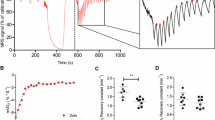Abstract
The relationship between maximal oxygen consumption rate (\(\dot V{\text{O}}_{{\text{2max}}}\)) and mitochondrial content of skeletal muscles was examined in horses and steers (n=3 each). Samples of the heart left ventricle, diaphragm,m. vastus medialis, m. semitendinosus, m. cutaneous thoracicus andm. masseter, as well as samples of muscles collected in a whole-body sampling procedure, were analyzed by electron microscopy.\(\dot V{\text{O}}_{{\text{2max}}}\) per kilogram body mass was 2.7× greater in horses than steers. This higher\(\dot V{\text{O}}_{{\text{2max}}}\) was in proportion to the higher total volume of mitochondria in horse versus steer muscle when analyzed from the whole-body samples and from the locomotor muscle samples. In non-locomotor muscles, total mitochondrial volume was greater in horses than steers, but not in proportion to their differences in\(\dot V{\text{O}}_{{\text{2max}}}\). The\(\dot V{\text{O}}_{{\text{2max}}}\) of the mitochondria was estimated to be close to 4.5 ml O2·ml−1 mitochondria in both species. It is concluded that in a comparison of a highly aerobic to a less aerobic mammalian species of similar body size, a higher oxidative potential may be found in all muscles of the more aerobic species. This greater oxidative potential is achieved by a greater total volume of skeletal muscle mitochondria.
Similar content being viewed by others
References
Brooks GA (1985) Anaerobic threshold: review of the concept and directions for future research. Med Sci Sports Exerc 17:22–31
Henriksson J, Reitman JS (1977) Time course of changes in human skeletal muscle succinate dehydrogenase and cytochrome oxidase activities and maximal oxygen uptake with physical activity and inactivity. Acta Physiol Scand 99:91–97
Hoppeler H (1986) Exercise-induced ultrastructural changes in skeletal muscle. Int J Sport Med 7:185–202
Hoppeler H, Mathieu O, Krauer R, Claassen H, Armstrong RB, Weibel ER (1981) Design of the mammalian respiratory system. VI. Distribution of mitochondria and capillaries in various muscles. Respir Physiol 44:87–111
Hoppeler H, Lindstedt SL, Uhlmann E, Niesel A, Cruz-Orive LM, Weibel ER (1984) Oxygen consumption and the composition of skeletal muscle tissue after training and inactivation in the European woodmouse (Apodemus sylvaticus). J Comp Physiol B 155:51–61
Hoppeler H, Kayar SR, Claassen H, Uhlmann E, Karas RH (1987) Adaptive variation in the mammalian respiratory system in relation to energetic demand. III. Skeletal muscles: setting the demand for oxygen. Respir Physiol 69:27–45
Jones JH, Longworth KE, Lindholm A, Conley KE, Karas RH, Kayar SR, Taylor CR (1988) Oxygen transport during exercise in large mammals. I. Dynamic and adaptive variation in oxygen demand. Am J Physiol (in press)
Kainulainen H, Ahomaki E, Vihko V (1984) Selected enzyme activities in mouse cardiac muscle during training and terminated training. Basic Res Cardiol 79:110–123
Karas RH, Taylor CR, Roesler K, Hoppeler H (1987) Adaptive variation in the mammalian respiratory system in relation to energetic demand. V. Limits to oxygen transport by the circulation. Respir Physiol 69:65–80
Mathieu O, Krauer R, Hoppler H, Gehr, P, Lindstedt SL, Alexander RMcN, Taylor CR, Weibel ER (1981) Designs of the mammalian respiratory system. VII. Scaling mitochondrial volume in skeletal muscle to body mass. Respir Physiol 44:113–128
Mendez J, Keys A (1960) Density and composition of mammalian muscle. Metabolism 9:184–188
Mitchell JH, Blomqvist G (1971) Maximal oxygen uptake. N Engl J Med 284:1018–1022
Prosser CL (1973) Comparative animal physiology. Saunders, Philadelphia, pp 165–211
Rösler KM, Conley KE, Claassen H, Howald H, Hoppeler H (1985) Transfer effects in endurance exercise: adaptations in trained and untrained muscles. Eur J Appl Physiol 54:355–362
Saltin B, Gollnick PD (1983) Skeletal muscle adaptability: significance for metabolism and performance. In: Peachy LD, Adrian RH, Geiger SR (eds) Handbook of physiology. Skeletal muscle. Williams and Wilkins, Baltimore, pp 555–631
Saltin B, Rowell LB (1980) Functional adaptation to physical activity and inactivity. Fed Proc 39:1506–1513
Taylor CR, Weibel ER, Karas RH, Hoppeler H (1987) Adaptive variation in the mammalian respiratory system in relation to energetic demand. VIII. Structural and functional design principles determining the limits to oxidative metabolism. Respir Physiol 69:117–127
Weibel ER (1979) Stereological methods, vol I. Practical methods for biological morphometry, chapters 4 and 6. Academic Press, New York, pp 101–235
Author information
Authors and Affiliations
Rights and permissions
About this article
Cite this article
Kayar, S.R., Hoppeler, H., Lindstedt, S.L. et al. Total muscle mitochondrial volume in relation to aerobic capacity of horses and steers. Pflugers Arch. 413, 343–347 (1989). https://doi.org/10.1007/BF00584481
Received:
Revised:
Accepted:
Issue Date:
DOI: https://doi.org/10.1007/BF00584481




